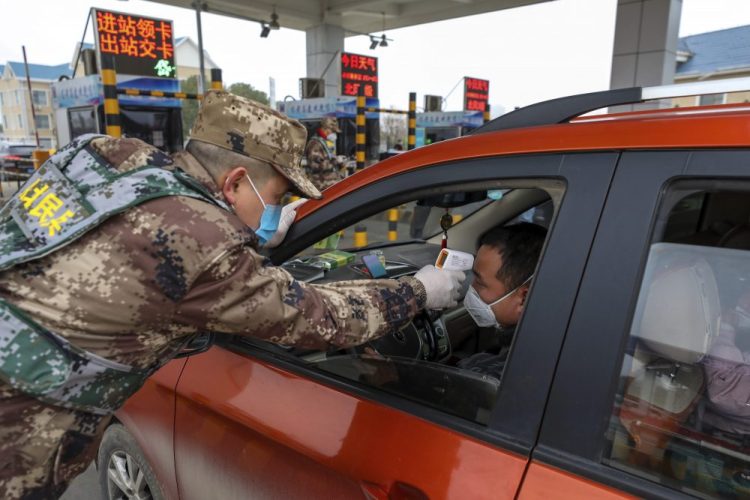BEIJING — China broadened its unprecedented, open-ended lockdowns to encompass more than 20.5 million people Friday to try to contain a deadly new virus that has sickened hundreds, even though the measures’ potential for success is uncertain.
At least six cities have been shut down, Wuhan, Ezhou, Huanggang, Chibi, Qianjiang and Xiantao, all in central China’s Hubei province, where the illness has been concentrated.
In Wuhan, where the lockdown began early Thursday, normally bustling streets, malls and other public spaces were eerily quiet. Masks were mandatory in public. The train station and airport were closed, and ferry, subway and bus service was halted; police checked all incoming vehicles but did not close off the roads.
The five other cities under lockdown as of Friday morning are near Wuhan, but authorities were taking precautions around the country. In the capital, Beijing, major public events were canceled indefinitely, including traditional temple fairs that are a staple of Lunar New Year celebrations. The Forbidden City, the palace complex in Beijing that is now a museum, announced it will close indefinitely on Saturday.
The number of confirmed cases of the new coronavirus rose to 830 with 25 deaths, the National Health Commission said Friday morning. The first death was also confirmed outside Hubei. The health commission in Hebei, a northern province bordering Beijing, said an 80-year-old man died after returning from a two-month stay in Wuhan to see relatives.
The vast majority of cases have been in and around Wuhan or people with connections the city. Outside the mainland, cases have been confirmed in Hong Kong, Macao, the United States, Japan, Taiwan, South Korea, Thailand, Singapore and Vietnam.
Many countries are screening travelers from China for symptoms of the virus, which can cause fever, coughing, breathing difficulties and pneumonia.
The World Health Organization decided against declaring the outbreak a global emergency for now. The declaration can increase resources to fight a threat but that can also cause trade and travel restrictions and other economic damage, making the decision politically fraught.
The decision “should not be taken as a sign that WHO does not think the situation is serious or that we’re not taking it seriously. Nothing could be further from the truth,” WHO Director General Tedros Adhanom Ghebreyesus said. “WHO is following this outbreak every minute of every day.”
Chinese officials have not said how long the shutdowns of the cities will last. While sweeping measures are typical of China’s Communist Party-led government, large-scale quarantines are rare around the world, even in deadly epidemics, because of concerns about infringing on people’s liberties. And the effectiveness of such measures is unclear.
“To my knowledge, trying to contain a city of 11 million people is new to science,” said Gauden Galea, the WHO’s representative in China. “It has not been tried before as a public health measure. We cannot at this stage say it will or it will not work.”
Jonathan Ball, a professor of virology at molecular virology at the University of Nottingham in Britain, said the lockdowns appear to be justified scientifically.
“Until there’s a better understanding of what the situation is, I think it’s not an unreasonable thing to do,” he said. “Anything that limits people’s travels during an outbreak would obviously work.”
But Ball cautioned that any such quarantine should be strictly time-limited. He added: “You have to make sure you communicate effectively about why this is being done. Otherwise you will lose the good will of the people.”

A worker hoses down garbage bins outside the closed Hankou Railway Station in Wuhan in central China’s Hubei Province on Thursday. Overnight, Wuhan authorities announced that the airport and train stations would be closed, and all public transportation suspended, by 10 a.m. Friday. Chinatopix via AP
During the devastating West Africa Ebola outbreak in 2014, Sierra Leone imposed a national three-day quarantine as health workers went door to door, searching for hidden cases. Burial teams collecting corpses and people taking the sick to Ebola centers were the only ones allowed to move freely. Frustrated residents complained of food shortages.
After Wuhan was was closed off, images showed long lines and empty shelves at supermarkets, as people stocked up. Trucks carrying supplies into the city are not being restricted, although many Chinese recall shortages in the years before the country’s recent economic boom.
Analysts predicted cases will continue to multiply, although the jump in numbers is also attributable in part to increased monitoring.
“Even if (cases) are in the thousands, this would not surprise us,” the WHO’s Galea said, adding, however, that the number of infected is not an indicator of the outbreak’s severity so long as the death rate remains low.
The coronavirus family includes the common cold as well as viruses that cause more serious illnesses, such as the SARS outbreak that spread from China to more than a dozen countries in 2002-03 and killed about 800 people, and Middle Eastern respiratory syndrome, or MERS, which is thought to have originated from camels.
The first cases in the Wuhan outbreak late last month were connected to a seafood market, and experts suspect transmission began from wild animals sold there. The market is closed for investigation.
China is keen to avoid repeating mistakes with its handling of SARS. For months, even after the illness had spread around the world, China used hotels and ambulances to conceal the true number of cases and avoid WHO experts. This time, China has been credited with sharing information rapidly, and President Xi Jinping has emphasized that as a priority.
Comments are not available on this story.
Send questions/comments to the editors.


